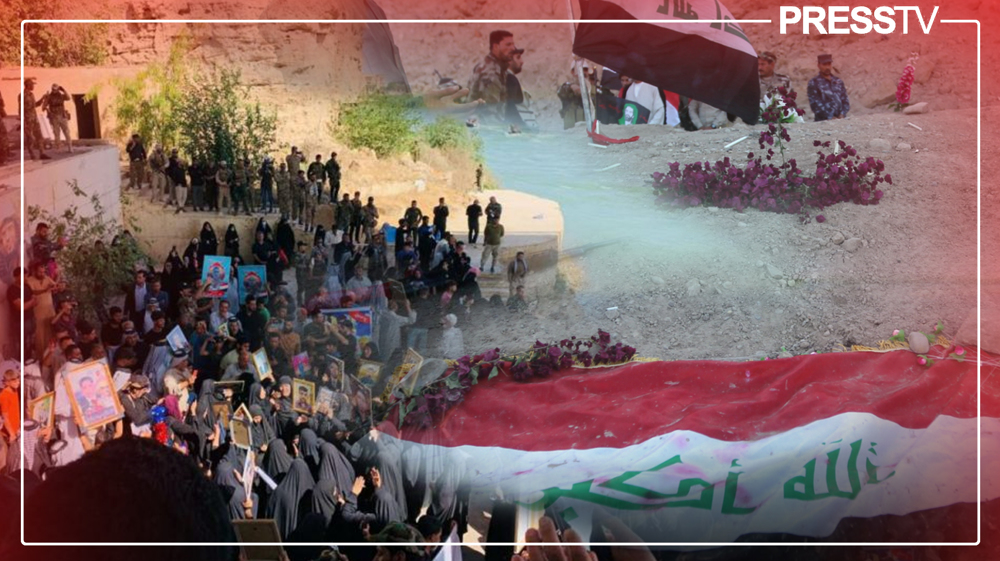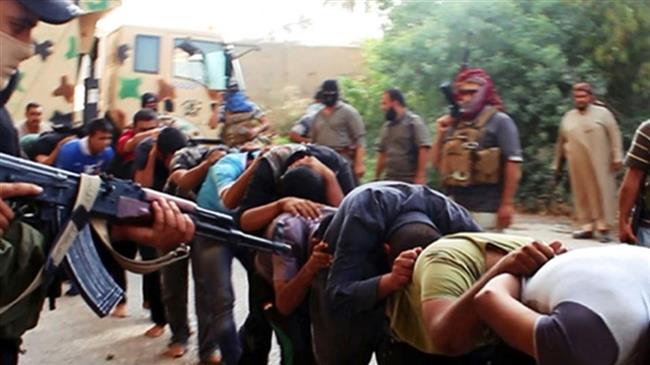Nine years since Speicher massacre when Daesh killed 1,700 Iraqi cadets
By Ivan Kesic
Nine years ago -- on June 12-13, 2014 -- Daesh terrorists captured and murdered at least 1,700 Iraqi Shi’a Air Force cadets outside Tikrit Air Academy (formerly known as Camp Speicher) in northern Iraq.
The brutal massacre of unarmed young cadets at the military base in Salah al-Din province of Iraq has been widely described as the worst example of terrorism perpetuated by the dreaded terrorist group.
The chilling footage of the incident, which circulated widely on social media immediately after the massacre, showed cadets falling off the back of trucks before being executed in cold blood at the corner of the Tigris River.
In 2015, mass graves were discovered in Tikrit, in which as many as 1,700 bodies were recovered, which sent ripples of shock and outrage across the world.
The carnage played a key role in the mobilization of young Iraqis against the Daesh terrorist group, backed by the call issued by the country’s top religious authority, Grand Ayatollah Sistani.
What happened?
The incident happened on June 12-13, when thousands of unarmed Iraqi cadets were training at Camp Speicher, a military base in Salah al-Din Governorate in north-central Iraq.
When news spread that Tikrit had fallen to Daesh, around 3,000 cadets were asked by their higher-ups to switch to civilian clothes, leave the camp, and head home for a 15-day break in order to be on the safe side.
According to the testimonies of survivors, the cadets were convinced that there was a safe corridor to the capital Baghdad in the south, protected by tribes loyal to the government.
However, on their way, they were caught by terrorist patrols and affiliated armed nomadic tribes.
In the aftermath of the incident, the terrorist group separated Sunnis from the Shias and non-Muslims and took them to different locations around Tikrit and killed them in the most brutal fashion, as narrated by eyewitnesses.
Some corpses were later dumped into mass graves while many others were thrown into the Tigris River.
How it happened
The local tribal leaders, who were mostly remnants of the once-ruling Baathist party, decided to hand over the Shia and non-Muslim prisoners to Daesh as revenge for the fate of the overthrown Tikrit-born dictator Saddam Hussein, while the Sunni prisoners were released on the condition of repentance.
The captured cadets, who were mostly students under the age of 20, were taken to Saddam's presidential palace in Tikrit among other locations around the city.
From June 12 to 13, according to eyewitness reports, they were executed one by one, mostly by shooting but also by beheading and burying alive.
According to witnesses, the Tigris water turned red from the blood of the bodies of these martyrs.
Daesh terrorists did not try to hide the crime but openly boasted about the slaughter of 1,700 cadets by posting shocking photos on social media networks.
The photographs released by the group showed terrified handcuffed Iraqi cadets forced to stand with their heads bent toward their knees, described in taunting captions.
Some photos showed bloodied and butchered corpses lying on the ground in at least five different locations, and firing squads garlanded with the Daesh flag preparing to kill scores of captives packed in shallow graves.
Western reactions
The initial reaction to the massacre in the Western mass media and human rights watchdogs was appalling. Despite evidence documenting the crime, as well as confirmation from Iraqi officials, it was still not enough for Western outlets to verify the massacre.
"We’re trying to verify the photos, and I am not convinced they are authentic," Erin Evers, the Human Rights Watch (HRW) researcher whose Twitter account is teeming with anti-Shia propaganda, told the New York Times two days after the massacre.
The Times' contributor Elizabeth Orcutt published an analysis of Daesh-published photographs, arguing that the images of killings should be doubted.
These two statements were picked up by dozens of other Western media outlets, and the slaughter of Shia teenagers was described for weeks as a claim, an alleged massacre, or even a mysterious event.
It remains an open question why verification was not given by the US military, which at the time of the massacre was simultaneously preparing for the battle of Tikrit, so there is no doubt that they had an aerial and satellite view of what was happening a few kilometers away.
Consequences in Iraq
The horrific massacre, the unpreparedness of the regular Iraqi army, and the suspicious US role had significant long-lasting consequences for the Arab country.
On June 13, 2014, Grand Ayatollah Sistani rallied the demoralized Iraqis from his headquarters in Najaf and issued a non-sectarian fatwa calling on able-bodied Iraqis to resist Daesh.
Two days later, on June 15, the Iraqi government officially formed the Popular Mobilization Units (PMU), composed of seven existing Shia units and joined by thousands of Sunni, Christian and other volunteers.
This united force, with selfless Iranian support, played a key role in defeating Daesh and liberating Iraq.
Following the victory over Daesh in Tikrit in early April 2015, mass graves containing some of the murdered cadets were located and the decomposed corpses began to be exhumed.
According to various sources, the Iraqi judicial authorities have so far issued death sentences for 112 people who were convicted of this crime, of which 76 have been executed so far.
UK ‘preemptively’ discharges pro-Palestine hunger strikers recovering in hospital
US dollar falls in Iran amid rising export currency supply
Trump’s ‘Board of Peace’ for Gaza an extension of Israeli occupation: Ex-UN rights chief
IMF expects Iran’s economy to grow by 1.1% in 2026
Over 9,350 Palestinians held in Israeli prisons as of early January: Rights groups
VIDEO | Press TV's news headlines
Israel plans to seize Palestinian-owned land in occupied East al-Quds
VIDEO | Displacement in Al-Ouja: A broader push to reshape the occupied West Bank















 This makes it easy to access the Press TV website
This makes it easy to access the Press TV website